Pteronophobia is the fear of feathers, feathered objects i.e., birds, or being tickled by feathers. As a turkey hunter I’ll go out on a limb and say turkey hunters aren’t likely to suffer the “fear of feathered objects” part of this affliction. Why? Aside from a turkey’s soul shaking gobble, its breathtakingly stunning plumage captivates us when a strutting spring gobbler’s sun-kissed feathers magically beam a kaleidoscope of colors declaring its majesty. Our hearts may skip a beat and breaths quicken, though not out of fear, but reverent gratitude. As you stroke the feathers of your next tagged turkey take a moment to contemplate the miracle of their perfection.
To better understand the form, function and maintenance of feathers important insight is included from wild turkey expert and researcher, Dr. Michael J. Chamberlain, PhD., Terrell Distinguished Professor of Wildlife Ecology and Management at Warnell School of Forestry and Natural Resources at the University of Georgia.

Tes Jolly
Wild Turkey Feather Facts
Feathers serve in insulation, waterproofing, protection, concealment and recognition. A turkey’s 5,000 to 6,000 feathers are arranged in tracts, or pterylae. Feathers are composed mostly of keratin, a strong lightweight protein as in our hair and nails. The hollow base is the quill, or calamus. While the feather is growing blood vessels pass through it. The supply cuts off when it’s fully grown. The shaft, or rachis is the midrib extending through the feather’s center giving it stiffness and structure. Rising from both sides of the shaft are small, pigment-embedded structures called barbs. Tiny barbules branch off and lock the barbs together. Tinier hooked barbicels at the barbule’s end hold the feathers completely interlocked in a Velcro like manner. Together they form the soft and colorful vane. Feathers are layered like shingles giving the body shape and aerodynamics necessary for flight. A muscle controls each feather allowing it to move left or right, up or down, fluff or lay flat.
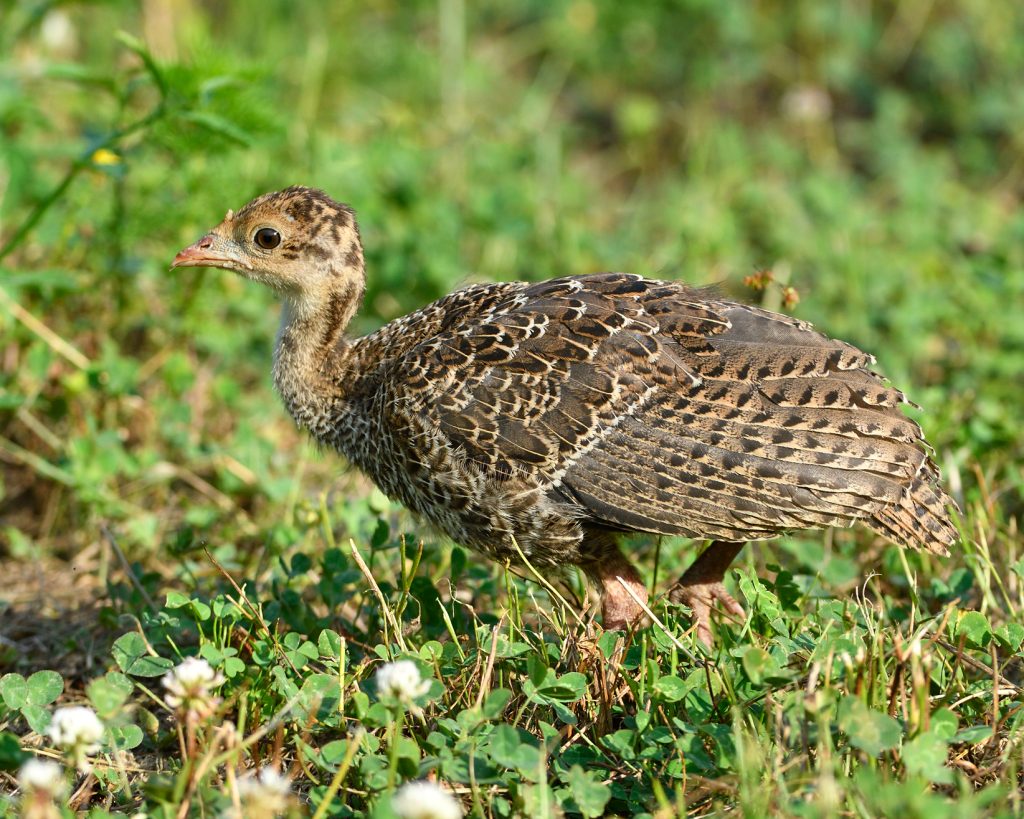
Tes Jolly
Turkey Feathers Types
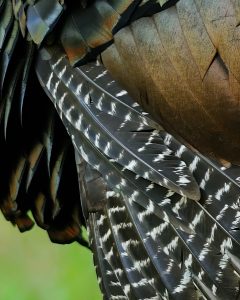
Tes Jolly
Primary feathers are the stiff, long feathers attached to the rump and wing. These include the typical 18 tail retrices, or fan feathers, which provide flight stability, steering and landing control for the heavy-bodied bird. During mating season, the colorfully displayed fan plays an important role in attracting hens and intimidating rivals. Tip colors in tail feathers and the covert feathers that cover their base vary with subspecies. Brown tips are characteristic of Osceolas, and Easterns. Rio Grandes have tan to buff tips and Merriam’s and Gould’s have whitish tips.
The ten black and white barred primary and 18 or 19 secondary flight feathers are called remiges. Extended, the primaries resemble outstretched fingers and have a long, slightly curved shaft with the vane narrower on the leading side than on the back. Shorter, wider secondaries support the primaries in their function. Specialized covert flight feathers overlay and protect the base of the wing feathers helping to shape them and provide warmth.
Dr. Chamberlain: Wing primaries are attached to the manus (the bird’s hand) and can be individually adjusted like fingers, offering agility in flight. The black and white barring is a way to age birds. Juveniles under a year-old lack barring at the ends of the outermost feathers. Toms use their primaries to draw attention while strutting. The feathers dragging the ground is distinctive to courtship displays. The amount of barring differs across the subspecies. Easterns have slightly more white than black barring, whereas Osceolas have little white barring which makes them appear almost black. Rio Grandes have wing barring that’s mostly equal black to white. Merriam’s and Gould’s have more white than black.
Contour, or body feathers give the bird its shape and colors. A tom’s contour feathers are typically dark with black tips while a hen’s are brownish or gray with
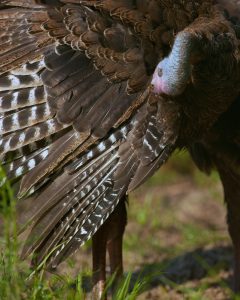
Tes Jolly
brown to light tips. Contour feathers are layered much like shingles in overlapping rows that form a protective waterproof layer that shields the body. Attached muscles allow the feathers to be held tightly against the body in warm temperatures or fluffed in cold weather to trap air for warmth.
Bristle feathers are hair like feathers that function as sensory tools and grow on the turkey’s head and neck. They’re well developed on hens as shown.
Dr. Chamberlain: We don’t know a ton about bristle feathers although they’ve been studied in other birds. I believe the ones that shield the ear are also bristle feathers, which makes sense because I suspect those feathers assist with sound to the ear and aid the bird in determining directions of sounds. I don’t know that, just a suspicion on my part. The beard is different than the bristle feathers, in that it’s a modified feather that serves primarily in mate attraction (and we believe) status amongst males but similar to other things with turkeys, we really lack an understanding of what all the beard does.
Down feathers, the soft, fluffy white feathers that grow close to the turkey’s body provide excellent insulation by trapping air between the body and the contour feathers. Poults are covered in natal down at hatching, which is rapidly replaced with juvenile feathers.
Turkey Feather Pigmentation and Iridescence Explained
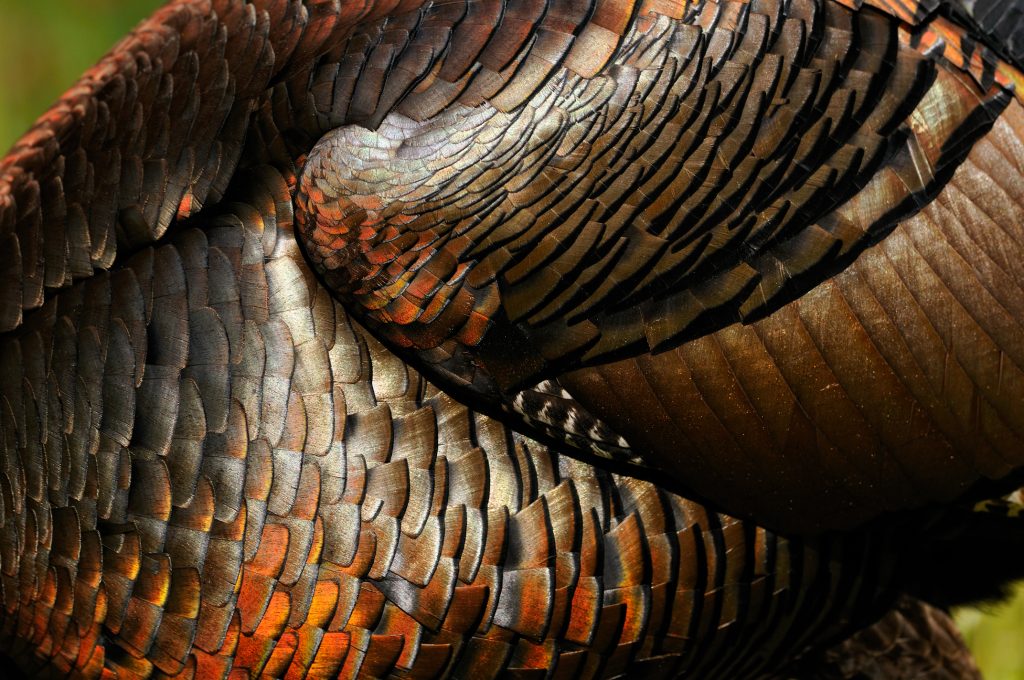
Tes Jolly
Colors in feathers are formed from pigments or from light refraction caused by the structure of the feather, or a combination of both. Pigments such as melanin are the colored substances found in turkey feathers. Melanin can produce colors from the darkest black to reddish browns and pale yellows. Color abnormalities occur when pigments are present or deficient at unusual levels such as in leucistic or melanistic color phases. Structural colors are produced by the structure of the feather as light is refracted. In wild turkeys, iridescence is caused by light refraction off the structure of the feather barbules.
Dr. Chamberlain: The brilliant colors are caused by light refracting off feathers, rather than feather colors. Crystals within the feathers block certain wavelengths of light but allow others to pass, which controls the intensity of colors. Iridescence which is the phenomenon where a surface appears to change colors as the angle of view changes, creates the brilliant shine that makes toms so stunning. Color and iridescence are an important part of the display toms use, and help hens determine the fittest tom in the breeding population.
Turkey Feather Preening & Molting
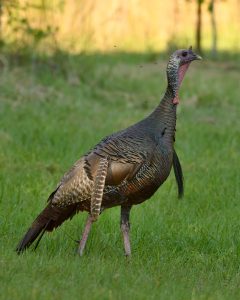
Tes Jolly
Feather preening serves a vital role in a turkey’s health overall:
- Feathers moisturized with oil from the uropygial gland are strong, flexible and better able to withstand the stress of flight.
- Feathers aligned for optimum waterproofing and insulation protect the bird against adverse conditions like extreme temperatures and soaking.
- Feathers aligned into their most aerodynamic shape provide for more efficient flight thus less energy is required.
- Feather parasite and body lice removal through dusting and sunning protects feathers and lessens disease outbreaks in the entire flock or nest.
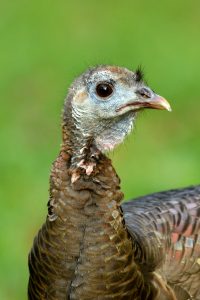
Tes Jolly
Molting or feather replacement occurs once a year in wild turkeys. This ensures they have a new set of plumage as winter approaches. During the molting and regrowth process preening removes tough sheaths from newly grown feathers and helps align them in the proper position more quickly.
Dr. Chamberlain: It generally takes 4 to 6 months depending on reproductive status of the bird. For toms, jakes, and hens that didn’t hatch a clutch, they have a more prolonged molt that begins after reproduction ends and stretches into fall, ending just before winter. For hens with broods, they get a later start but then appear to have an accelerated molt that has them finishing at the same time as everyone else. Regardless, you’re looking at a process that takes up 1/3 of the calendar relative to their annual cycle. Flight is not affected by molting, nor is protection because feathers are lost in a way where the adjacent feathers on each tract are not molted at the same time. When molting, the feathers are often dropped in pairs (termed bilateral symmetry). For instance, a primary feather on one wing is lost and replaced at the same time as that same feather on the other wing.









